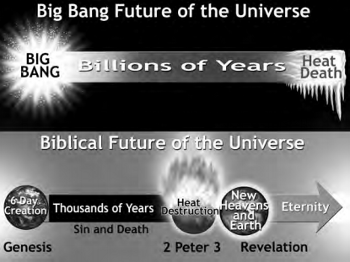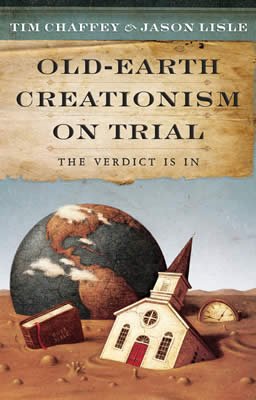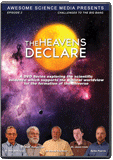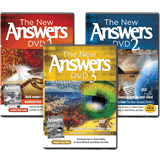
The Big-Bang God or the God of Scripture?
Appendix E
Some people have suggested that God (or a god) used a “big bang” to create the universe.
Some people have suggested that God (or a god) used a “big bang” to create the universe. The big bang is the secular model of how the universe formed. However, the consistent Christian has no need to speculate on how and when God might have created the universe. The Creator himself has left a written record that summarizes His creative acts—a record that contradicts the big-bang model on many points. Sadly, many people are inclined to ignore what God has said about what He did. Instead, they rely on secular philosophy to reconstruct a past that contradicts the recorded history and eyewitness testimony of the Bible.
What if someone rejected recorded history and claimed that World War I never happened because his philosophy does not allow for the possibility of a world war.
Can you imagine if people applied such thinking to other fields of study? What if someone rejected recorded history and claimed that World War I never happened because his philosophy does not allow for the possibility of a world war. Would this be reasonable? These days, it is common for people to reject the possibility of a supernatural, biblical creation simply because they embrace the philosophy of naturalism—the belief that “nature is all that there is.”
Naturalism and uniformitarianism are the driving philosophies behind the big bang. That is, the big-bang model attempts to describe the formation of the entire universe by processes currently operating within the universe. Stars, planets, and galaxies are all said to have formed “naturalistically”—by the laws of nature currently in operation. The expansion of the universe is assumed to be naturalistic and uniformitarian in the big-bang model.
In chapter 7, we explored the errors of naturalistic and uniformitarian thinking, and how such notions lead to incorrect conclusions. The big bang is simply one of many incorrect conclusions derived from secular assumptions. It is not compatible with the Bible. Therefore, Christians should reject it. Let’s summarize a few of the differences.
The big bang accepts the secular order of events, not the biblical order (see Appendix B). For example, stars come before the earth in the big bang, but the order is reversed in the Bible. The big bang teaches that the universe is billions of years old, whereas the Bible teaches only thousands of years. The big bang teaches that the first stars formed by natural processes, but the Bible teaches that God made the stars (Gen. 1:14–16).

The big bang is really just a story about the alleged past. But few people realize that it is also a story about the alleged future. The big-bang model (in the most accepted variation) claims that our universe will expand forever and usable energy will eventually all be converted to a useless form; no life will be possible at that point. It’s a bleak outlook, and one that is vastly different from the Bible’s description of the future. Scripture teaches that there will be a resurrection, judgment, and then a restoration of paradise. Clearly, the Bible is not compatible with the big bang. Unfortunately, too few Christians realize the many contradictions between the big-bang story and the recorded history of the Bible.
Jumping on the Big-Bang Bandwagon
It is becoming increasingly popular for apologetics ministries to cite the big-bang theory as evidence or proof for the existence of God. This is not necessarily a new phenomenon, since Dr. Hugh Ross has been doing this for years in his lectures, books, and website. Unfortunately, it seems to be gaining momentum and many well-known apologists are falling for it, including John Ankerberg, Lee Strobel, and Norman Geisler. There are several problems with this approach.
First, there is a real danger in claiming that the Bible is consistent with the big bang (or worse—to say, as some do, that the Bible teaches the big bang). The Bible is the Word of God and does not change. The big-bang theory changes regularly. Dr. Ross used to claim that the universe was 17 billion years old (give or take 3 billion years).1 In 2004, Ross claimed that scientists now know the universe is 13.7 billion years old—this is 300 million years outside of his previous “known” range. In addition, many astronomers have posited different ages for the universe ranging from 7–20 billion years. So which one does the Bible “teach”? Ross is forced to reinterpret the Bible every time the theory changes.
Second, the big-bang theory does not provide evidence for the God of the Bible. At best, the big bang posits a beginning to the universe and therefore, a cause. However, that cause need not be divine. Carl Sagan and Isaac Asimov popularized the oscillating universe idea,2 in which the cause is a previous universe. So the big bang in no way proves the biblical account. The Muslim could make the exact same claim. So does the big-bang theory support the belief that Allah created everything?
Third, the Bible does not need us to invent or use fallacious evidence to support its claims. In fact, the Bible warns against following such concepts based on human reasoning rather than God’s Word (Col. 2:8). There is enough scientific evidence to confirm the Bible without adding the big-bang theory to the mix. What happens if and/or when scientists stop believing in the big-bang theory and come up with a new theory? A number of scientists are already doing just that!3
Finally, and most importantly, the Bible just does not support the big-bang theory nor does the big-bang theory support the Bible. They are contradictory on many issues. Those who claim that the big bang (or any other old-earth ideas) supports the Bible are unwittingly misleading the Church in this area. Consider the following examples.
First, in his Systematic Theology: Volume One, Norman Geisler makes the following claims:

a) The Bible teaches that everything came into existence in the “exact order that modern science” has discovered. He goes on to list this order: “the universe came first, then the earth, then the land and sea. After this came life in the sea, then land animals, and finally, last of all, human beings.”4 Actually, the Bible states that the sea was created before the land. Other than that discrepancy, the Bible certainly does teach this order. Nevertheless, Geisler’s comments are misleading. First, when the Bible teaches that “God created the heavens and the earth” (Gen 1:1), this does not include the sun, moon, and stars since these were made on the fourth day (Gen 1:14–19). The big-bang adherents teach that the sun evolved before the earth, while the Bible teaches that the earth came first. Second, Geisler conveniently leaves out the creation of the flying creatures on the fifth day. This contradicts the evolutionary belief of many scientists since they believe birds evolved from land animals (reptiles). There is no way to reconcile this with the biblical account without ignoring or twisting Scripture.
b) On pages 300–301 of the same book, Geisler implies that belief in a six-day creation is tantamount to believing that the sun orbits the earth. He cites Martin Luther’s argument as an example. Luther wrongly believed in a geocentric solar system and used Joshua’s account of the long day (Josh. 10:12) as evidence. However, neither Joshua nor any other biblical author makes a statement that undoubtedly teaches geocentricity. Geisler proceeds to add one of Luther’s comments about a six-day creation as if this is as erroneous as believing in geocentricity. Not only is this a case of comparing apples to oranges, it is misleading because it assumes that science has proven a six-day creation to be wrong—which it has not.
Second, Dr. Hugh Ross has made the claim that life could not exist unless the universe was about 14 billion years old.5 Yet Dr. Ross is well aware that the Bible teaches that one day God will create new heavens and a new earth. He does not believe this will take billions of years to create. If God can and will create this new place instantaneously (or at least in a short time) then why could He not do this with the original creation? Such inconsistent thinking is typical of old-earth theology. Dr. Ross routinely places limits on God that God has not placed on himself. Dr. Ross claims that the “transcendent Creator is at least a trillion, trillion, trillion, trillion, trillion, trillion, trillion, trillion times more intelligent than the people at Cal Tech.”6 While this sounds impressive, it is demeaning to the God who is infinitely more intelligent than any person. Those who believe in a young earth are often ridiculed for limiting God; however, the shoe is actually on the other foot. We limit ourselves to taking God at His Word. According to Dr. Ross, it is impossible for God to have created everything in six days of approximately 24 hours each—even though His Word clearly teaches that He did. One is reminded of Jesus’ statement in Matthew 22:29, “You are mistaken, not knowing the Scriptures nor the power of God.
” Who is really placing limits on God?
The Bible does not imply or teach the big-bang theory. In fact, the Bible and the big bang teach the opposite on nearly every major event of history. The Bible teaches very plainly that God created everything in the span of six literal days of approximately 24 hours each (Genesis 1; Exodus 20:11, 31:17–18). Any attempt to compromise this teaching produces serious theological errors, as shown in Appendix B. Christians need to learn to trust in God’s Word because “it is better to trust in the Lord than to put confidence in man
” (Ps. 118:8). God says what He means and means what He says—let’s not add man’s fallible and changing opinions to His perfect Word.
What about the Scientific Evidence?
Many people don’t realize that the big bang is not only bad theology, but it is bad science as well. Is the big bang the same kind of science that put men on the moon, or allows your computer to function? Not at all. The big bang isn’t testable, repeatable laboratory science. It doesn’t make specific predictions that are later confirmed by observation and experimentation. In fact, the big bang is at odds with a number of principles of real operational science. Let’s explore just a few of these.
The fact that we don’t find any monopoles suggests that the universe never was that hot; this indicates that there never was a big bang.
One significant issue is the problem of the “missing monopoles.” A “monopole” is a hypothetical massive particle that is just like a magnet, but with only one pole. So, a monopole would have either a “north” pole, or a “south” pole, but not both. Particle physicists claim that magnetic monopoles should have been created in the high temperature conditions of the big bang. Since monopoles are predicted to be stable, they should have lasted to this day. Yet, despite considerable search efforts, monopoles have not been found. Where are the monopoles? The fact that we don’t find any monopoles suggests that the universe never was that hot; this indicates that there never was a big bang. But it’s perfectly consistent with the Bible’s account of creation, since the universe did not start at extremely high temperatures.
Consider the “baryon number problem.” The big bang supposes that matter (hydrogen and helium gas) was created from energy as the universe expanded. However, experimental physics tells us that whenever matter is created from energy, such a reaction also produces antimatter. Antimatter has similar properties to matter, except the charges of the particles are reversed. (So whereas a proton has a positive charge, an anti-proton has a negative charge.) In any reaction where energy is transformed into matter, it produces an exactly equal amount of antimatter; there are no known exceptions.
The big bang (which has no matter to begin with—only energy) should have produced precisely equal amounts of matter and antimatter. Thus, if the big bang were true, there should be an exactly equal amount of matter and antimatter in the universe today. But there is not. The visible universe is comprised almost entirely of matter—with only trace amounts of antimatter anywhere.
Additionally, there are many lines of evidence that indicate the universe is much younger than billions of years. Spiral galaxies are an example of this. These galaxies rotate differentially—meaning the inner portions rotate faster than the outer portions. So the spiral structure is constantly becoming tighter and tighter. If these galaxies were really billions of years old, they would be so twisted up that the spiral structure could not be seen. But we do see countless numbers of spiral galaxies—indicating they are much younger than the big bang teaches.
What to Make of the Scientific Problems
Of course, big-bang supporters often propose various solutions to these problems. These “rescuing devices” attempt to save the big-bang model from all the contrary evidence. These hypotheses have problems of their own, for which there are proposed solutions (which themselves have problems and so on). For example, the “spiral density wave” hypothesis is supposed to preserve the spiral structure of galaxies to accommodate the big-bang time scale, but is inconsistent with the magnetic fields that permeate galaxies, for which another hypothesis must be invoked.
So, the problems listed above (and many others that were not included in this book) are not to be taken as “proofs” that the big bang is wrong. Big-bang supporters can always invoke a rescuing device. It is the Bible that proves the big bang wrong. The scientific problems with the big bang merely confirm this. They are symptomatic of the fact that the big bang is not true.
In fact, in order for science to be possible, biblical creation must be true. We saw in chapter 7 how the Bible alone provides the necessary preconditions for scientific analysis. Only if there is a God who is beyond time and who upholds the universe in a consistent fashion (the future universe operates like the past universe) can the testable/repeatable nature of the scientific method make any sense. Yet, God’s promise to uphold the future as He has the past is given in the Book of Genesis. Specifically, Genesis 8:22 tells us that there are certain cycles we can count on in the future. Only biblical creation explains why we have an orderly, logical universe and minds that can interpret that universe. Without the straightforward teachings of the Bible (and Genesis in particular), what basis would we have for the uniformity we see in nature? Without biblical creation, what right would we have to expect that science is even possible?
By attempting to use science to support his case, the big-bang supporter has actually philosophically destroyed his own position. The big-bang supporter may attempt to argue that science refutes biblical (young-earth) creation, but he is using something (science) that makes no sense without biblical creation. In order for his scientific argument to make sense, it would necessarily have to be wrong. Science cannot exist apart from its foundation: the biblical God. And so the big bang is nothing more than an exercise in unbiblical, vain philosophy—the kind the Bible warns us about in Colossians 2:8.
Conclusions
There simply is no rational reason to believe in the big bang. It is not compatible with the Bible, and it’s not good science. We have sampled just a few of the scientific difficulties with the big bang. Although secular astronomers have proposed potential solutions to such problems, we suggest that such problems are symptomatic of the underlying incorrect worldview. The big bang erroneously assumes that the universe was not supernaturally created, but that it came about by natural processes. However, reality does not comport with this notion. Science confirms the message of the Bible: “In the beginning, God created the heaven and the earth.”
Old-Earth Creationism on Trial
Opting to skirt the controversy of Genesis as literal history, the biblical authority of the Holy Word is called into question and reduced to a collection of mere stories.
Read Online Buy BookFootnotes
- Cited by Mark Van Bebber and Paul S. Taylor in Creation and Time (Mesa, AZ: Eden Communications, 1994), p. 109.
- This view states that a series of big bangs occurs every 20–100 billion years and that the universe is eternal. In the past, this view was largely abandoned due to thermodynamic problems. However, a version of this model has regained some support more recently. Philosophically, this view fails because if matter were eternal, then an infinite number of days would have to be traversed before today. It is impossible to traverse an infinite number of days; therefore, there must be a beginning and a Beginner to “begin” the universe.
- The reader is again referred to the paper mentioned in chapter 1. It is available at <http://www.cosmologystatement.org>.
- Norman L. Geisler, Systematic Theology: Volume One (Minneapolis, MN: Bethany House, 2002), p. 545.
- He made this claim in a debate with Dr. Kent Hovind on the John Ankerberg Show and also at the Intelligent Design 2004 Conference in Highlands, North Carolina, in June 2004. Ironically, in 1996, Ross told a chapel session at Dallas Theological Seminary that “it only works in a cosmos of a hundred-billion trillion stars that’s precisely sixteen-billion-years old.”
- Dr. Ross stated this at the ID 2004 Conference. See previous footnote for details.
Recommended Resources

Answers in Genesis is an apologetics ministry, dedicated to helping Christians defend their faith and proclaim the good news of Jesus Christ.
- Customer Service 800.778.3390
- © 2024 Answers in Genesis




